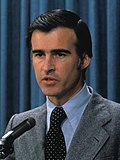Background
The 1992 presidential election cycle began during a period of economic uncertainty, with the United States experiencing a recession that had started in 1990. President George H. W. Bush's approval ratings had fallen dramatically from their post-Gulf War highs, creating an opportunity for Democratic challengers. [2] Several high-profile Democrats, including New York Governor Mario Cuomo and Jesse Jackson, opted not to run, leaving a relatively open field. [3]
The traditional importance of the New Hampshire primary was heightened in 1992 because the Iowa caucuses, typically the first major contest of the primary season, were effectively bypassed by most candidates due to the presence of Iowa Senator Tom Harkin in the race. This made New Hampshire the first meaningful test of candidate strength in the 1992 nomination process. [4]
Campaign
Early developments
The primary campaign in New Hampshire was marked by intense retail politics, with candidates participating in numerous town halls, house parties, and local events across the state. Paul Tsongas, from neighboring Massachusetts, initially held an advantage due to regional familiarity and his message of economic revitalization focused on manufacturing and investment. [5]
On January 19, The Boston Globe published a poll showing Clinton leading with 29%, Tsongas at 17%, and Bob Kerrey at 16%. However, this lead would prove short-lived as Clinton's campaign faced multiple crises in the following weeks. [4]
Clinton campaign challenges
The Clinton campaign weathered several major controversies during the New Hampshire primary period. In late January, tabloid reports emerged alleging a twelve-year extramarital affair between Clinton and Gennifer Flowers. Clinton's poll numbers plummeted in the aftermath of these allegations. [3] The scandal was compounded by intensifying questions about Clinton's actions during the Vietnam War and his efforts to avoid the draft, including scrutiny of a letter he had written to the ROTC program. [6]
During this period, Clinton also faced controversy over his decision to return to Arkansas during the campaign to oversee the execution of Ricky Ray Rector, a mentally impaired death row inmate. The execution drew both praise from law-and-order voters and criticism from death penalty opponents, adding another layer of complexity to Clinton's campaign narrative. [7]
In response to these mounting challenges, Bill and Hillary Clinton appeared on 60 Minutes immediately following Super Bowl XXVI to address the Flowers allegations. This interview became a crucial moment in salvaging Clinton's campaign, particularly when Hillary Clinton memorably declared she was not "some little woman standing by my man like Tammy Wynette." The couple's joint appearance helped stabilize the campaign and began to shift media narrative away from the scandal. [3]
Final stretch
The last weeks of the campaign saw Tsongas maintaining a steady lead in polls, while Clinton focused on economic messages and personal connections with voters. His campaign emphasized his background and understanding of working-class struggles, contrasting with Tsongas's more technocratic approach. [8] Clinton's personal campaigning style, characterized by long hours of direct voter contact and emotional connections with constituents, proved particularly effective in the state's retail political environment. [4]
Historical significance
The 1992 New Hampshire primary proved historically significant in transforming the nature of modern presidential campaigns. It established Clinton's reputation for political resilience and demonstrated the possibility of surviving major scandals in modern media-driven campaigns. [12] Notably, it marked the first time a candidate would go on to win the presidency despite not winning the New Hampshire primary as a non-incumbent.
Clinton's performance in New Hampshire set a precedent for future presidential candidates. In subsequent elections, George W. Bush, Barack Obama, and Joe Biden would also win the presidency despite losing the New Hampshire primary as non-incumbents, suggesting a shift in the primary's traditional role as a kingmaker in presidential politics. [13]
This page is based on this
Wikipedia article Text is available under the
CC BY-SA 4.0 license; additional terms may apply.
Images, videos and audio are available under their respective licenses.






